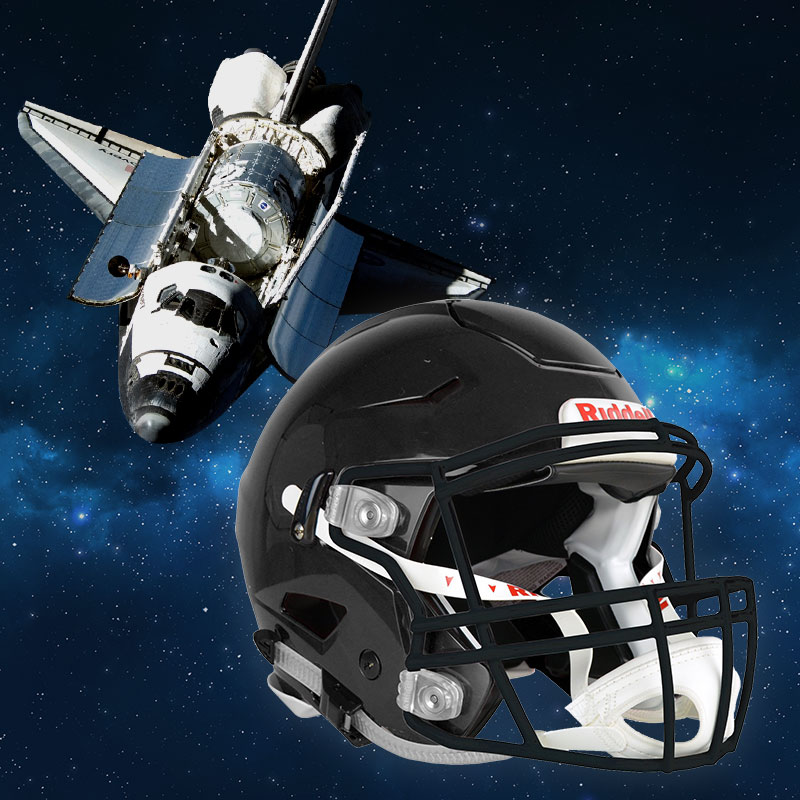We know the future is bright, as today’s young minds continue to astonish us all with their ingenuity. At Sports Unlimited, we understand the importance of fostering this brilliance, and continued education is a key piece to this equation. That is why the annual Sports Unlimited Scholarship was created, providing assistance to those who will drive us forward.
Requiring an essay submission on a particular topic, the scholarship is awarded to the individual who best displays creative thinking and resourcefulness. This year’s prompt asked students to identify a piece of gear or equipment currently used in a sport and describe how to improve it and why. Over a thousand essays were sent in, each of which described an innovative vision. Covering a range of sports and equipment from football to fencing, basketball to badminton.

This year’s winner took on the popular topic of football helmet improvement, but was able to pull from a unique source of inspiration. Using the design elements of the space shuttle, Paul Wasuwanich of Orlando, Florida was able to provide a compelling argument for how the football helmet should be redeveloped. And because of this, Sports Unlimited was proud to offer him a scholarship of a $1000, as he heads off to the University of Notre Dame this fall.
Read Paul’s submission, entitled “Rocket Grade Defense”:

Astronauts and football players have a lot more in common than many might think. They both work in extreme environment and therefore require extreme protection. Astronauts must survive in the harsh environments of space full of deadly radiation, destructive space debris, and freezing temperatures. Football players, on the other hand, must survive on the dangerous football field full of 300 pound opponents ready to tackle them with up to one ton of force, about 4 times the force required to crush a human skull according the Journal of Neurosurgery: Pediatrics [4]. To protect from such threats, engineers have devised multiple defenses to keep astronauts and football players safe. One of those defenses is the helmet.
A football helmet is as important to the player as a space helmet is to an astronaut. Fatality is imminent if that crucial device is absent. It is easy to see how a man would suffocate in space without his space helmet, but harder to visualize the internal damage a football player suffers with each blow to the head. According to statistics from the NFL, there were 271 diagnosed concussions in the 2015 season [2]. Having closely studied the brain with my professor, Dr. Mohtashem Samsam, a neurologist from the University of Central Florida, I understand clearly that the previously mentioned 271 concussions is much more than the number suggests. Concussions result from severe head trauma, but football players receive much more head traumas that do not produce acute effects such as the concussion. A progressive degenerative disease called chronic traumatic encephalopathy (CTE) plagues football players who have received severe or multiple head traumas. In a 2014 study from Boston University, of 79 brains from former NFL players, 76 tested positive for CTE [1]. Brains with CTE are similar in appearance and function to brains with Huntington’s disease.
Today, we are so used to hearing about football concussions that they have become accepted as inevitable, but they are not. Over the years, football equipment has improved, reducing the number of concussions and the severity of brain damage. No helmets became leather helmets, and leather helmets became the modern football helmets we see today. The modern helmet is still not sufficient and can be further improved to reduce the number of concussions even more.
In space, an astronaut’s first line of defense are walls of his spacecraft which are designed to protect against space debris moving at up to an astonishing 17,500 mph [5]. This technology can be applied to the football helmet. The walls of spacecrafts come in my varieties, but they have the same basic design, multiple layers of a thin, light, hard material (e.g. aluminum alloy) with soft material (e.g. foam) in between [3]. The goal of this defense is not to deflect the impacting object as football helmets do, but to significantly reduce the force of the object so that it would not penetrate the inner walls of the spacecraft. The outer walls of the spacecraft do two things to prevent penetration of the spacecraft, one of those is increasing the time it takes the object to hit inner walls. It is a physics concept shown by the formula:
I = FΔt
I = Impulse or change in momentum
F = Force
Δt = Change in time
In this case, the impulse is constant, so by increasing the time of impact, we can decrease the force of object when it hits in the inner wall. Having alternating layers of hard and soft defenses means the object or shock wave must pass through multiple materials with different properties. It takes a shock wave more time to pass through two different materials than one material of the same amount. The football helmet should be designed as such: A thin outer layer of a hard, light material (e.g. carbon fiber), followed by a soft material (e.g. foam), a hard material again, a soft material again, then a thick hard layer, and finally a soft cushion for the head.
Other than increasing the time of impact, the outer walls of the spacecraft also deforms. Deformation, unlike deflection, absorbs the energy of the impact. A football player wearing a helmet that deforms on impact will experience less force to the head than a football player wearing a helmet that deflects the impact force. The reason cars crumble in crashes is not because of the force of impact, but because engineers designed the car to absorb as much energy as possible by deforming in order to protect the driver. Although football helmets that deform on impact will have to be frequently replaced, it is worth the improvement in safety.
Broken bones can heal, torn muscles can be repaired, but dead brain cells cannot be replaced, therefore, head protection in a sport as aggressive as American football is of uttermost importance.
Sports Unlimited would like to thank all of those who submitted an essay for this year’s scholarship. We will be sharing a few of our other finalist’s ideas in the near future. The prompt for the 2018 Sports Unlimited Scholarship will be available soon, so be sure to check back!
Written By Dylan Hamilton, Sports Unlimited
